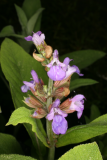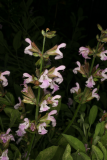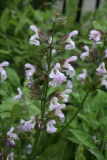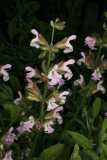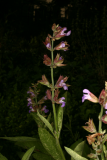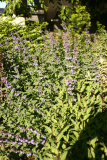Additional notes (click to expand)
Horticulture
An evergreen, highly aromatic, shrubby perennial, growing to 60cm (2ft) it has downy, roughly-textured, hairy, grey-green, ovate leaves to 8cm long and spikes of tubular, violet-blue flowers in early summer. A popular culinary herb. 80cm high by 1m wide. Winter hardy. Mediterranean and N. Africa. Introduced in cool temperate regions.
Prune in spring or just after flowering but avoid cutting into old wood. After a few years, Salvia officinalis become straggly and need replacing.
Brickell, C. (2003). A-Z Encyclopedia of Garden Plants. Dorling Kindersley. p.952
Medicinal
Traditional Herbal Medicine Registration (THMR).
Culpeper: ‘Salvia. Sage. ... it stays abortion in those women that are subjedt to come before their times, it causeth fruitfulness, it is singular good for the brain, it strengthens the senses and memory, helps spitting and vomiting of blood.
Culpeper, Nicholas. (1650). A Physical Directory . London, Peter Cole.
An astringent, antiseptic and antibacterial herb. Infusions of the leaves are used as a gargle or mouthwash for sore throat, mouth ulcers, gum disease, laryngitis and tonsillitis. Infusions are taken internally as tonics, to aid digestion and for menopausal problems and applied externally as compresses to help heal wounds.
Bird, R, Houdret, J. (2000). Kitchen and Herb Gardener. Lorenz. p.447
Since ancient times and the Middle Ages this herb was held in high repute. An old saying: “Why should a man die whilst sage grows in his garden? In France, the herb is supposed to mitigate grief, mental and bodily, and in Pepys in his Diary he says: ‘Between Gosport and Southampton we observed a little churchyard where it was customary to sow all the graves with Sage”.
'Mrs Grieves (1931) A Modern Herbal' at www.botanical.com
Medicinal uses
Uses supported by clinical data
The management of mild to moderate Alzheimer disease (52).
Uses described in pharmacopoeias and well established documents
Salvia offi cinalis is used internally for treatment of infl uenza, bronchitis,
sinusitis, meningitis and neuritis (53). The European Scientifi c Cooperative
on Phytotherapy supports the use of S. offi cinalis leaves for stomatitis
and gingivitis (27). The German Standard Licence for S. offi cinalis infusion also indicates its use for the supportive treatment of dyspeptic symptoms
and gastrointestinal catarrh (5).
Uses described in traditional medicine
Traditionally S. offi cinalis has been used to treat hoarseness and coughs
(54, 55). It is also used as a sedative, tonic, and stimulant (56). Salvia offi -
cinalis has a long history of use as a restorative of lost or declining cognitive
functions in Western European systems of traditional medicine (57).
Salvia offi cinalis leaves are also used for treatment of haemorrhages, hyperhydrosis,
galactorrhoea and dysentery (58–60). In traditional Italian
medicine, they are used to treat rheumatism (61, 62). The use of S. offi cinalis
for the treatment of menstrual disorders has been reported (63, 64).
It is also used to treat acne, hair loss and dandruff, as a vulnerary and an
antiseptic (65, 66).
Contraindications
In view of the toxicity of the plant due to the thujone and camphor content,
extracts should be used with caution and not ingested in large
amounts (95). Because of the known toxic properties of thujone, the described
abortifacient properties (96), and lack of safety data concerning
administration of Folium Salviae and its preparations in children as well
as during pregnancy and lactation, it is contraindicated in these patient
groups (38, 97).
WHO monographs on medicinal plants commonly used in the Newly Independent States (NIS). 2010. WHO, Geneva
Nomenclature
Sal’via- The Latin name presumably derived from "salvus"- safe, well, sound, from the supposed medicinal values of the plants.
Stearn, W.T. (1996). Dictionary of Plant Names for Gardeners. Cassell. p.265
officinalis- sold in shops, applied to plants with real or supposed medicinal properties.
Stearn, W.T. (1996). Dictionary of Plant Names for Gardeners. Cassell. p.222
Other use
Notes: Used as a gargle to relieve toothache in herbal medicine. Widely used as a flavouring in cooking e.g. sage and onion stuffing used for poultry dishes.
Oakeley, Dr. H. F. . (2013). The Gardens of the Pharmacopoeia Londinensis.
link
The name Salvia meaning 'healthy'. Elizabeth Blackwell (1737) wrote that it had '... all the noble Properties of the other hot Plants; more especially for the Head, Memory, Eyes, and all Paralytical Affections. In short, 'tis a Plant endu'd with so many and wonderful Properties, as that the assiduous use of it is said to render Men Immortal" with which Hans Sloane agreed. Its health giving properties were recorded in the aphorisms of the School of Salerno (fl 9-13th century) - quoted in the Decameron [ c.1350, translated: Why should man die when Salvia grows in the Garden']. Some salvias, such as Salvia divinorum, contain hallucinogenic compounds.
Oakeley, Dr. Henry F. (2013). Wellcome Library notes.
link
Indication: relief of excessive sweating associated with menopausal hot flushes/night sweats
From Patient information leaflet for preparations licensed as Traditional Herbal remedies in the UK
Medicines and Health Care Regulatory Authority, 2013 Licensed Traditional Herbal Remedies
But who can write thy worth (O soveraigne Sage)
Some aske how man can die, where thou dost grow
Oh that were a medicine curing age
Death comes at last, thoughdeath comes ne're so slow:
Sage strengths the sinewes, fevers heat doth swage,
The Palsy helpes , and rids of mickle woe.
In Latin (Salvia) takes the name of safety
In English (Sage) is rather wise than crafty
Sith then the name betokens wise and saving,
We count it natures friend and worth having.
Harrington (Translator), Sir John. (1608). The Englishman's Doctor or The School of Salerne. John Helme and John Busby Junior, Fleet Street.
Toxicity
Side effects/precautions: do not use with hypersensitivity, rare hereditary problems of fructose intolerance, glucose-galactose malabsorption or sucrase-isomaltase insufficiency, with medicines acting via GABA receptor, pregnancy/breast feeding
From Patient information leaflet for preparations licensed as Traditional Herbal remedies in the UK
Oakeley, Dr. H.F. (2013). Medicines from RCP plants label list 5-2013.docx.
Geographical distribution
- Europe, Southeastern Europe, Albania
- Europe, Southeastern Europe, Greece
- Europe, Southeastern Europe, Italy
- Europe, Southeastern Europe, Yugoslavia
Podcast
Salvia officinalis L.
Family: LAMIACEAEGenus: Salvia
Species: officinalis L.
Common names: Sage
Pharmacopoeia Londinensis name: Salvia
Distribution summary: Mediterranean
Conservation status (IUCN Red List): Least Concern
Habit: Shrub
Hardiness: H5 - Hardy; cold winter
Habitat: Rocky slopes
Garden status: Currently grown
Garden location: Europe & Mediterranean (E), Europe & Mediterranean (E), Classical Europe & Middle East (I), Pharmacopoeia Londinensis 1618 'Leaves' (HSE 5), Plants in pots (POT)
Flowering months: June, July, August
Reason for growing: Medicinal, other use, traditional herbal registration
.JPG)
.JPG)


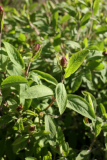
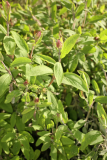
.JPG)
